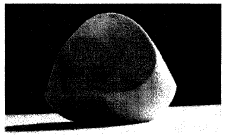This was the question facing the Court of Justice (CJEU)[i] in relation to an application to register the Gömböc, a convex three-dimensional homogeneous body that, when resting on a flat surface, has just one stable and one unstable point of equilibrium. The Gömböc’s shape ensures that the object always rights itself, returning to a position of balance. The existence of such a shape has solved a long-standing mathematical mystery.
 A Gömböc as pictured on the register
A Gömböc as pictured on the register
Some shapes unregistrable
Although the shape of a product may in principle be registered as a trade mark, certain shapes are excluded from registration. A prime example is where the shape is necessary to obtain a technical result, such as in the case of the lego brick[ii], which has been denied registration on this ground. A further example is where the shape gives “substantial value to the goods”. This exclusion applies typically – but not exclusively - in the case of ornamental goods where the customer is likely to choose goods on the basis of the shape[iii]. Where product shapes are excluded on these grounds, the shape may already enjoy a substantial reputation because it symbolises a successful product. The policy reason for not allowing trade mark protection is that trade marks can be renewed indefinitely, so they can potentially shield the product itself from competition for a long period, even after any relevant patent or design right has run out.
Questions before the CJEU in the case of the Gömböc
The case concerned an application by Gömböc Kft. to register the shape of the Gömböc as a 3D national mark in Hungary in respect of decorative items and toys. The Supreme Court of Hungary referred three preliminary questions on points of EU law to the CJEU.
Technical result – does public perception matter?
The Court asked whether, in deciding if a particular shape is necessary to obtain a technical result, one could refer not only to the representation of the object on the trade mark register but also to other information, such as the public’s perception. This was of particular importance in this case as the Gömböc is very well known in some circles and the public are likely to know that its shape gives it the ability to right itself. The Court held that information other than that relating to the representation alone, such as the perception of the relevant public, may be referred to. However, the information about technical function must originate from objective and reliable sources.
Substantial value – does public perception matter?
The Hungarian first instance court had taken the view that the value of the product related to its shape as a tangible symbol of mathematical discovery and that this made the shape special and striking. This was not evident from the representation of the Gömböc on the register but would be well-known to the public in some circles. The CJEU held that the perception or knowledge of the relevant public may be taken into account when identifying an essential characteristic of the product. The question will be whether it is clear from objective and reliable evidence that the consumer’s decision to purchase the product is to a great extent determined by that characteristic (i.e. the fact that the shape embodied a mathematical principle).
Prior design rights and decorative items
The Hungarian court also asked whether the fact that the shape is protected by a design right or is a decorative item automatically results in it being excluded from trade mark protection on the basis that it is the shape which gives substantial value to the goods. The CJEU advised that neither the existence of a design right nor the fact that the shape has artistic or ornamental value necessarily excludes the shape from registration on this basis if the other conditions for registration are met.
Implications of the case
Trade mark applicants will welcome the CJEU’s guidance on the role of the public perception, clarifying that the public perception may be relevant in deciding whether these exclusions apply, but that there must be objective and reliable evidence before the court. The court also usefully clarifies that neither the existence of a design right nor the fact that a shape has artistic or ornamental value automatically excludes the shape from registration as a trade mark. Although in some cases artistic or ornamental shapes may be excluded from registration, this will only arise where it is apparent that the purchasing decision is based to a very large extent on the shape. The case will now go back to the Hungarian court, which will apply the CJEU’s guidance in deciding whether the Gömböc can be registered. Although, taken on its own, the CJEU’s guidance might suggest that the likelihood of registration is slim, there are likely to be a number of factors in play, not least in terms of what evidence is before the Hungarian court, so this is difficult to predict with confidence.
 Elena Cafora
Elena Cafora